2014 NISSAN VERSA NOTE tire pressure
[x] Cancel search: tire pressurePage 338 of 372
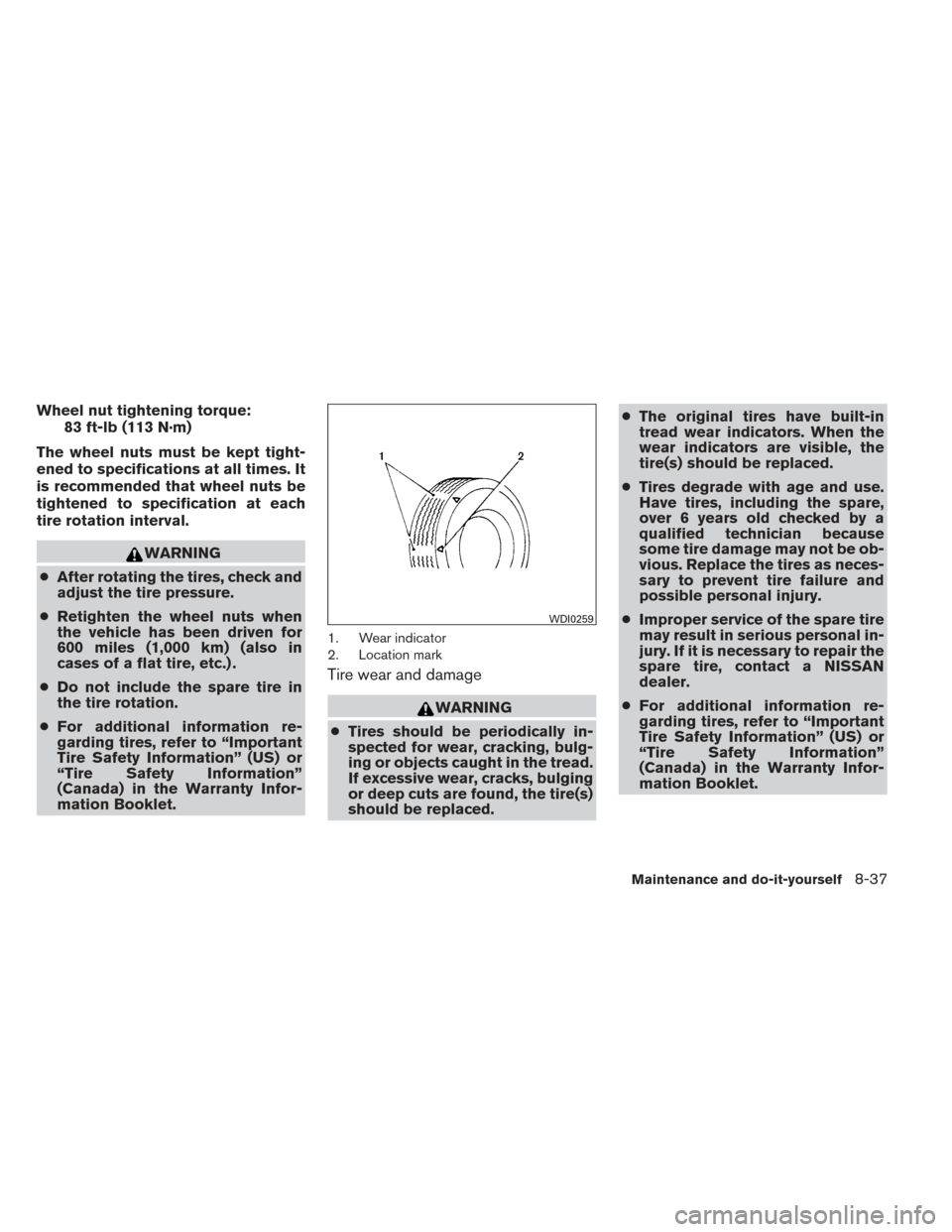
Wheel nut tightening torque:83 ft-lb (113 N·m)
The wheel nuts must be kept tight-
ened to specifications at all times. It
is recommended that wheel nuts be
tightened to specification at each
tire rotation interval.
WARNING
● After rotating the tires, check and
adjust the tire pressure.
● Retighten the wheel nuts when
the vehicle has been driven for
600 miles (1,000 km) (also in
cases of a flat tire, etc.) .
● Do not include the spare tire in
the tire rotation.
● For additional information re-
garding tires, refer to “Important
Tire Safety Information” (US) or
“Tire Safety Information”
(Canada) in the Warranty Infor-
mation Booklet.
1. Wear indicator
2. Location mark
Tire wear and damage
WARNING
● Tires should be periodically in-
spected for wear, cracking, bulg-
ing or objects caught in the tread.
If excessive wear, cracks, bulging
or deep cuts are found, the tire(s)
should be replaced. ●
The original tires have built-in
tread wear indicators. When the
wear indicators are visible, the
tire(s) should be replaced.
● Tires degrade with age and use.
Have tires, including the spare,
over 6 years old checked by a
qualified technician because
some tire damage may not be ob-
vious. Replace the tires as neces-
sary to prevent tire failure and
possible personal injury.
● Improper service of the spare tire
may result in serious personal in-
jury. If it is necessary to repair the
spare tire, contact a NISSAN
dealer.
● For additional information re-
garding tires, refer to “Important
Tire Safety Information” (US) or
“Tire Safety Information”
(Canada) in the Warranty Infor-
mation Booklet.
WDI0259
Maintenance and do-it-yourself8-37
Page 339 of 372
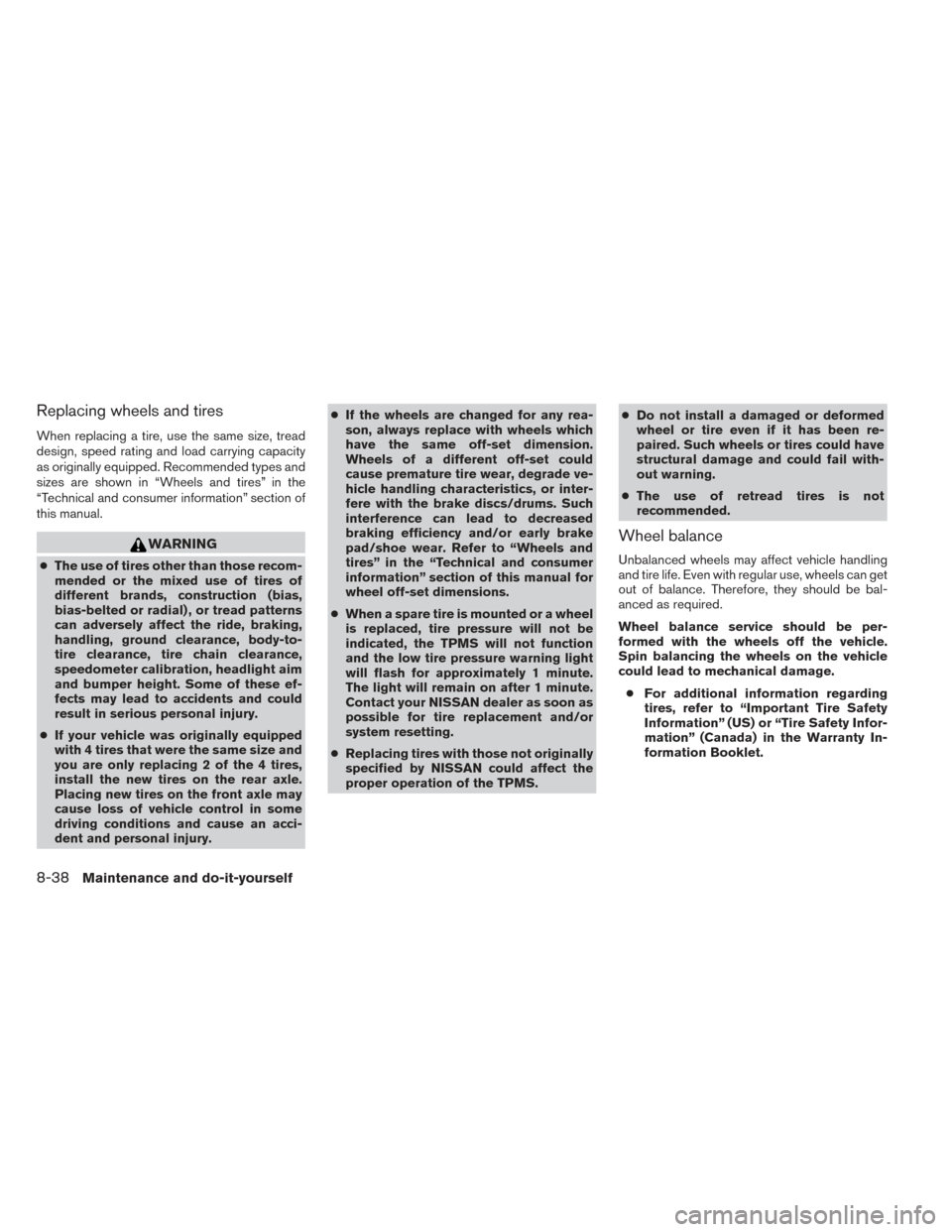
Replacing wheels and tires
When replacing a tire, use the same size, tread
design, speed rating and load carrying capacity
as originally equipped. Recommended types and
sizes are shown in “Wheels and tires” in the
“Technical and consumer information” section of
this manual.
WARNING
●The use of tires other than those recom-
mended or the mixed use of tires of
different brands, construction (bias,
bias-belted or radial) , or tread patterns
can adversely affect the ride, braking,
handling, ground clearance, body-to-
tire clearance, tire chain clearance,
speedometer calibration, headlight aim
and bumper height. Some of these ef-
fects may lead to accidents and could
result in serious personal injury.
● If your vehicle was originally equipped
with 4 tires that were the same size and
you are only replacing 2 of the 4 tires,
install the new tires on the rear axle.
Placing new tires on the front axle may
cause loss of vehicle control in some
driving conditions and cause an acci-
dent and personal injury. ●
If the wheels are changed for any rea-
son, always replace with wheels which
have the same off-set dimension.
Wheels of a different off-set could
cause premature tire wear, degrade ve-
hicle handling characteristics, or inter-
fere with the brake discs/drums. Such
interference can lead to decreased
braking efficiency and/or early brake
pad/shoe wear. Refer to “Wheels and
tires” in the “Technical and consumer
information” section of this manual for
wheel off-set dimensions.
● When a spare tire is mounted or a wheel
is replaced, tire pressure will not be
indicated, the TPMS will not function
and the low tire pressure warning light
will flash for approximately 1 minute.
The light will remain on after 1 minute.
Contact your NISSAN dealer as soon as
possible for tire replacement and/or
system resetting.
● Replacing tires with those not originally
specified by NISSAN could affect the
proper operation of the TPMS. ●
Do not install a damaged or deformed
wheel or tire even if it has been re-
paired. Such wheels or tires could have
structural damage and could fail with-
out warning.
● The use of retread tires is not
recommended.
Wheel balance
Unbalanced wheels may affect vehicle handling
and tire life. Even with regular use, wheels can get
out of balance. Therefore, they should be bal-
anced as required.
Wheel balance service should be per-
formed with the wheels off the vehicle.
Spin balancing the wheels on the vehicle
could lead to mechanical damage.
● For additional information regarding
tires, refer to “Important Tire Safety
Information” (US) or “Tire Safety Infor-
mation” (Canada) in the Warranty In-
formation Booklet.
8-38Maintenance and do-it-yourself
Page 340 of 372
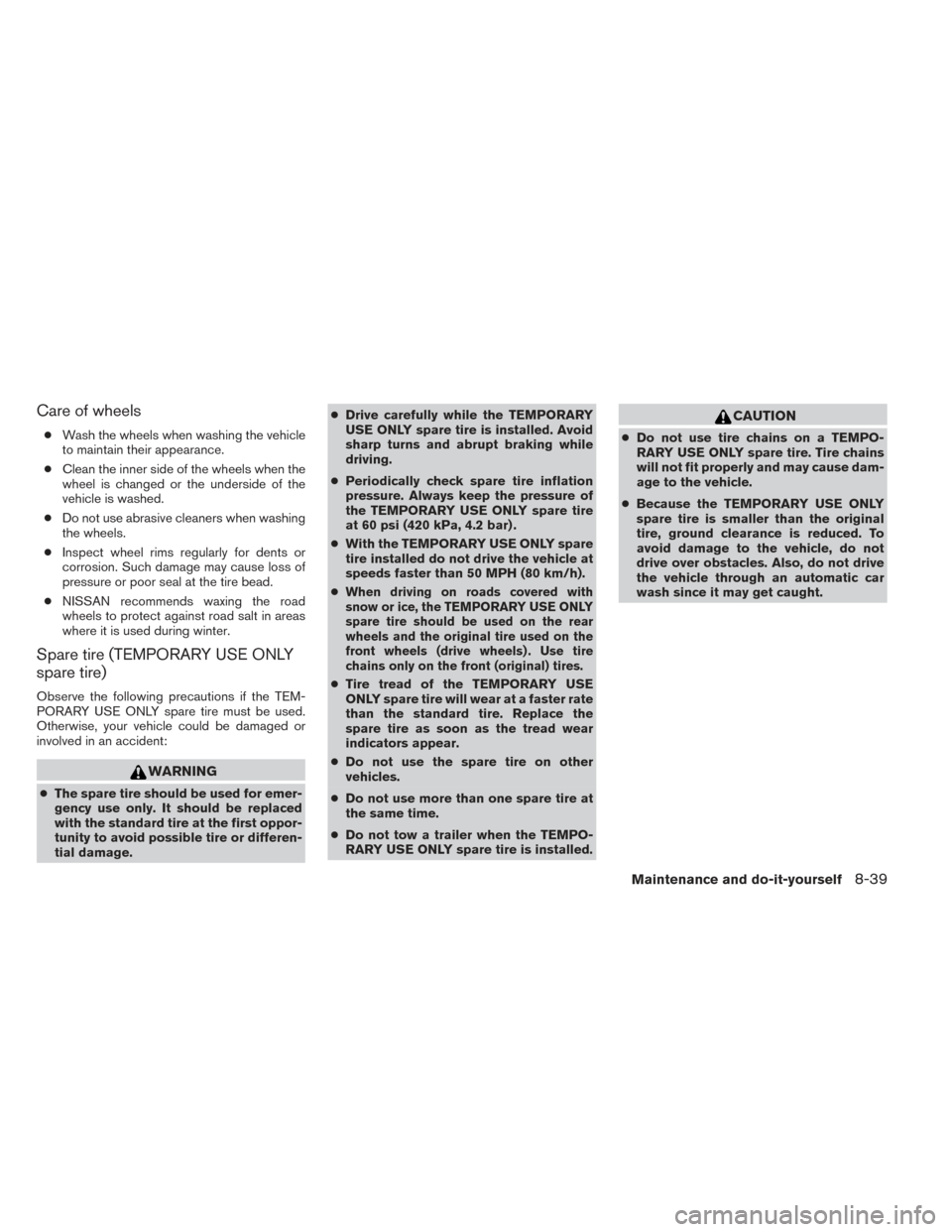
Care of wheels
●Wash the wheels when washing the vehicle
to maintain their appearance.
● Clean the inner side of the wheels when the
wheel is changed or the underside of the
vehicle is washed.
● Do not use abrasive cleaners when washing
the wheels.
● Inspect wheel rims regularly for dents or
corrosion. Such damage may cause loss of
pressure or poor seal at the tire bead.
● NISSAN recommends waxing the road
wheels to protect against road salt in areas
where it is used during winter.
Spare tire (TEMPORARY USE ONLY
spare tire)
Observe the following precautions if the TEM-
PORARY USE ONLY spare tire must be used.
Otherwise, your vehicle could be damaged or
involved in an accident:
WARNING
● The spare tire should be used for emer-
gency use only. It should be replaced
with the standard tire at the first oppor-
tunity to avoid possible tire or differen-
tial damage. ●
Drive carefully while the TEMPORARY
USE ONLY spare tire is installed. Avoid
sharp turns and abrupt braking while
driving.
● Periodically check spare tire inflation
pressure. Always keep the pressure of
the TEMPORARY USE ONLY spare tire
at 60 psi (420 kPa, 4.2 bar) .
● With the TEMPORARY USE ONLY spare
tire installed do not drive the vehicle at
speeds faster than 50 MPH (80 km/h).
●
When driving on roads covered with
snow or ice, the TEMPORARY USE ONLY
spare tire should be used on the rear
wheels and the original tire used on the
front wheels (drive wheels) . Use tire
chains only on the front (original) tires.
● Tire tread of the TEMPORARY USE
ONLY spare tire will wear at a faster rate
than the standard tire. Replace the
spare tire as soon as the tread wear
indicators appear.
● Do not use the spare tire on other
vehicles.
● Do not use more than one spare tire at
the same time.
● Do not tow a trailer when the TEMPO-
RARY USE ONLY spare tire is installed.
CAUTION
● Do not use tire chains on a TEMPO-
RARY USE ONLY spare tire. Tire chains
will not fit properly and may cause dam-
age to the vehicle.
● Because the TEMPORARY USE ONLY
spare tire is smaller than the original
tire, ground clearance is reduced. To
avoid damage to the vehicle, do not
drive over obstacles. Also, do not drive
the vehicle through an automatic car
wash since it may get caught.
Maintenance and do-it-yourself8-39
Page 353 of 372

TIRE AND LOADING INFORMATION
LABEL
The cold tire pressure is shown on the Tire and
Loading Information label. The label is located as
shown.
AIR CONDITIONER SPECIFICATION
LABEL (if so equipped)
The air conditioner specification label is affixed as
shown.
LTI0197LTI2067
9-12Technical and consumer information
Page 365 of 372

Clock.......................4-38(models without navigation system) ....4-38
Clockset.....................4-38
C.M.V.S.S. certification label ..........9-11
Cold weather driving ...............5-30
Compact disc (CD) player ....4-39,4-44,4-50
Continuously Variable Transmission (CVT) . . .5-15 Continuously Variable Transmission
(CVT) fluid ..................8-11
Driving with Continuously Variable
Transmission (CVT) .............5-15
Control panel buttons ...............4-2
Brightness/contrast button ..........4-9
Enterbutton..................4-2
Setting button .................4-5
Controls Audiocontrols(steeringwheel).......4-67
Heater and air conditioner controls .....4-21
Coolant Capacities and recommended
fuel/lubricants .................9-2
Changing engine coolant ...........8-8
Checking engine coolant level ........8-8
Engine coolant temperature gauge .....2-6
Corrosionprotection ...............7-5
Cruisecontrol..................5-21
Cupholders...................2-28
Curtain side-impact air bag system
(See supplemental side air bag and curtain
side-impact air bag system) ...........1-51
D
Daytime running light system (Canada only) . .2-22 Defroster switch
Rear window defroster switch .......2-20
Dimensionsandweights.............9-9
Dimmer switch for instrument panel ......2-22
Display controls (see control panel buttons) . .4-2
Door locks .....................3-5
Door open warning light .............2-11
Drive belt .....................8-15
Driving Cold weather driving .............5-30
Driving with Continuously Variable
Transmission (CVT) .............5-15
Driving with manual transmission ......5-18
Precautions when starting and driving ....5-2
E
Economy - fuel ..................5-24
Emission control information label .......9-11
Emission control system warranty .......9-18
Engine Before starting the engine ..........5-13
Block heater .................5-31
Capacities and recommended
fuel/lubricants .................9-2
Changingenginecoolant...........8-8
Changingengineoil..............8-9
Changing engine oil filter ..........8-10
Checking engine coolant level ........8-8
Checking engine oil level ...........8-8
Engine compartment check locations ....8-6
Engine coolant temperature gauge .....2-6
Engine cooling system ............8-7
Engineoil ...................8-8
Engine oil and oil filter recommendation . . .9-6 Engine oil pressure warning light
......2-11
Engine oil viscosity ..............9-6
Engine serial number ............9-11
Engine specifications .............9-8
Starting the engine .............5-14
Enterbutton....................4-2
Eventdatarecorders ..............9-20
Exhaustgas(Carbonmonoxide).........5-2
Extended storage switch ............8-21
F
Flashers (See hazard warning flasher switch) . .6-2
Flat tire .......................6-3
Floor mat positioning aid .............7-5
Fluid Brake
fluid..................8-11
Capacities and recommended
fuel/lubricants .................9-2
Continuously Variable Transmission
(CVT) fluid ..................8-11
Engine coolant .................8-7
Engine oil ...................8-8
F.M.V.S.S. certification label ...........9-11
Foglightswitch .................2-23
Front air bag system
(See supplemental restraint system) ......1-46
Front seats .....................1-2
Fuel Capacities and recommended
fuel/lubricants .................9-2
Fuel economy ................5-24
Fuel-filler door and cap ...........3-26
Fuel-filler door lock opener lever ......3-26
Fuelgauge...................2-6
10-2
Page 367 of 372
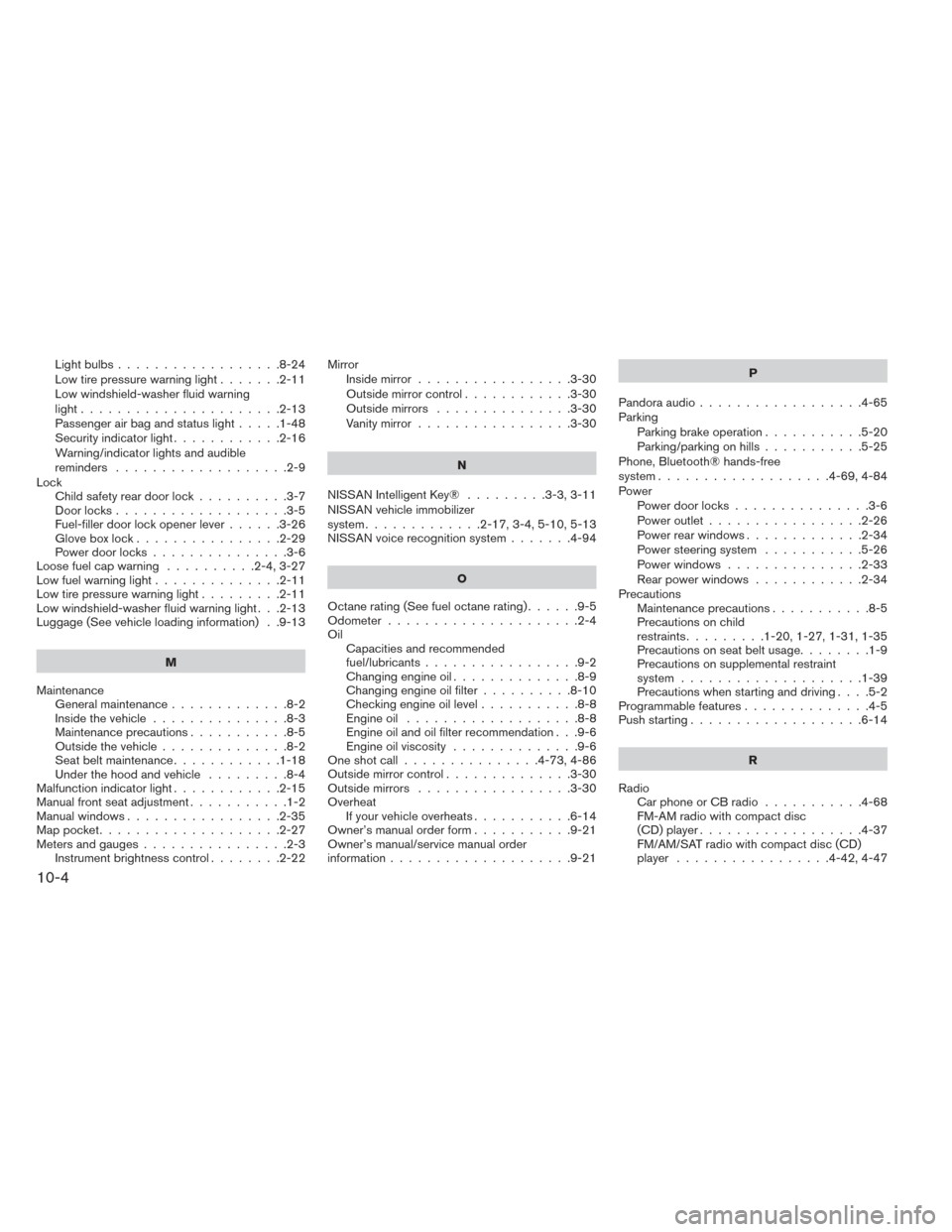
Lightbulbs..................8-24
Low tire pressure warning light.......2-11
Low windshield-washer fluid warning
light......................2-13
Passenger air bag and status light .....1-48
Security indicator light ............2-16
Warning/indicator lights and audible
reminders ...................2-9
Lock Child safety rear door lock ..........3-7
Door locks ...................3-5
Fuel-filler door lock opener lever ......3-26
Gloveboxlock................2-29
Power door locks ...............3-6
Loose fuel cap warning ..........2-4,3-27
Lowfuelwarninglight..............2-11
Low tire pressure warning light .........2-11
Low windshield-washer fluid warning light . . .2-13
Luggage (See vehicle loading information) . .9-13
M
Maintenance Generalmaintenance.............8-2
Insidethevehicle...............8-3
Maintenanceprecautions...........8-5
Outsidethevehicle..............8-2
Seat belt maintenance ............1-18
Under the hood and vehicle .........8-4
Malfunction indicator light ............2-15
Manual front seat adjustment ...........1-2
Manual windows .................2-35
Map pocket ....................2-27
Meters and gauges ................2-3
Instrument brightness control ........2-22Mirror
Inside mirror .................3-30
Outside mirror control ............3-30
Outside mirrors ...............3-30
Vanity mirror .................3-30
N
NISSAN Intelligent Key® .........3-3,3-11
NISSAN vehicle immobilizer
system .............2-17,3-4,5-10,5-13
NISSAN voice recognition system .......4-94
O
Octane rating (See fuel octane rating) ......9-5
Odometer .....................2-4
Oil Capacities and recommended
fuel/lubricants .................9-2
Changingengineoil..............8-9
Changing engine oil filter ..........8-10
Checking engine oil level ...........8-8
Engineoil ...................8-8
Engine oil and oil filter recommendation . . .9-6
Engine oil viscosity ..............9-6
Oneshotcall...............4-73,4-86
Outside mirror control ..............3-30
Outside mirrors .................3-30
Overheat If your vehicle overheats ...........6-14
Owner’s manual order form ...........9-21
Owner’s manual/service manual order
information ....................9-21 P
Pandora audio ..................4-65
Parking Parking brake operation ...........5-20
Parking/parking on hills ...........5-25
Phone, Bluetooth® hands-free
system ...................4-69,4-84
Power Power door locks ...............3-6
Power outlet .................2-26
Power rear windows .............2-34
Power steering system ...........5-26
Power windows ...............
2-33
Rear power windows ............2-34
Precautions Maintenanceprecautions...........8-5
Precautions on child
restraints .........1-20,1-27,1-31,1-35
Precautions on seat belt usage ........1-9
Precautions on supplemental restraint
system ....................1-39
Precautions when starting and driving ....5-2
Programmablefeatures..............4-5
Push starting ...................6-14
R
Radio CarphoneorCBradio ...........4-68
FM-AM radio with compact disc
(CD) player ..................4-37
FM/AM/SAT radio with compact disc (CD)
player .................4-42,4-47
10-4
Page 369 of 372
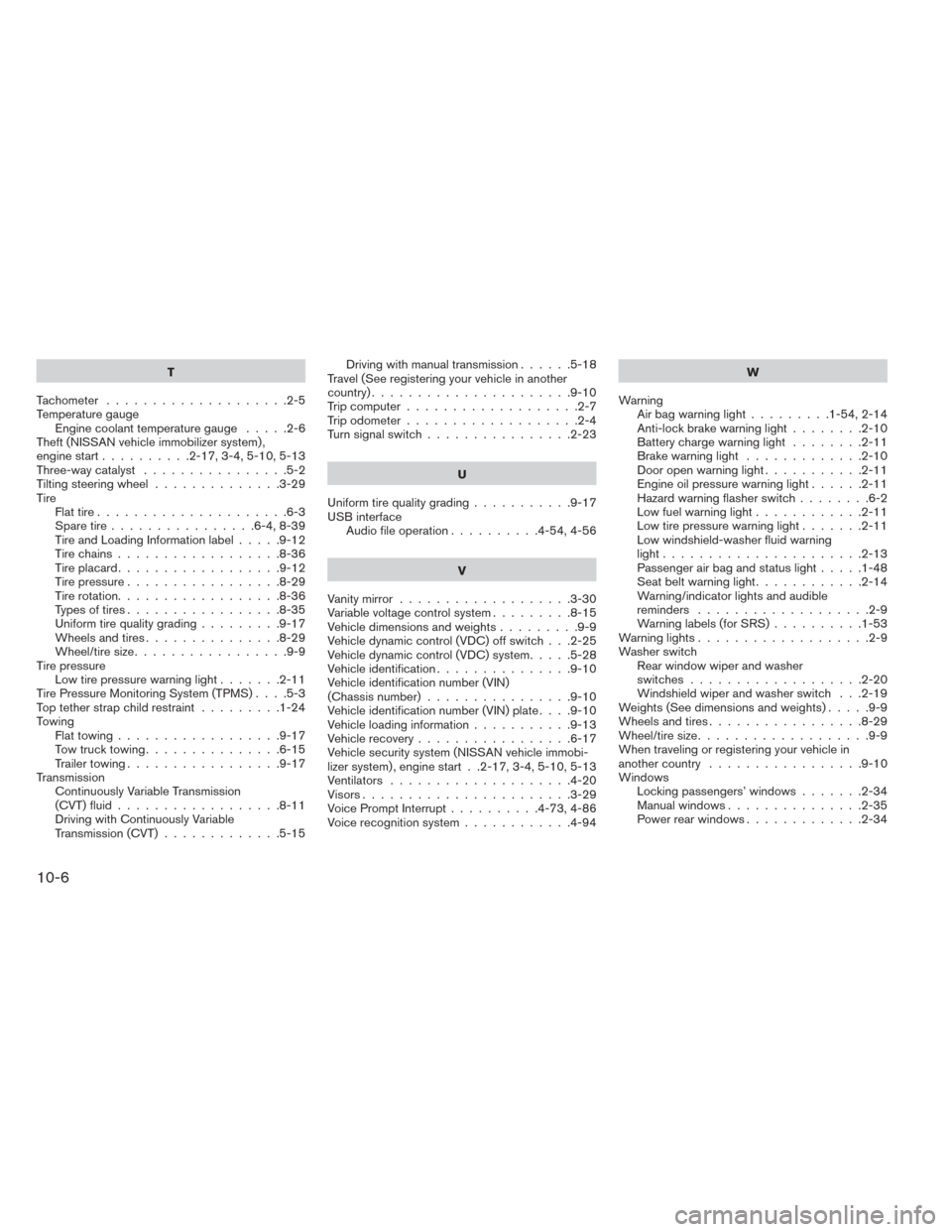
T
Tachometer ....................2-5
Temperature gauge Engine coolant temperature gauge .....2-6
Theft (NISSAN vehicle immobilizer system) ,
engine start ..........2-17,3-4,5-10,5-13
Three-way catalyst ................5-2
Tilting steering wheel ..............3-29
Tire Flat tire .....................6-3
Spare tire ................6-4,8-39
Tire and Loading Information label .....9-12
Tire chains ..................8-36
Tireplacard..................9-12
Tirepressure.................8-29
Tire rotation..................8-36
Types of tires .................8-35
Uniform tire quality grading .........9-17
Wheels and tires ...............8-29
Wheel/tire size .................9-9
Tire pressure Low tire pressure warning light .......2-11
Tire Pressure Monitoring System (TPMS) ....5-3
Top tether strap child restraint .........1-24
Towing Flattowing..................9-17
Towtrucktowing...............6-15
Trailertowing.................9-17
Transmission Continuously Variable Transmission
(CVT) fluid ..................8-11
Driving with Continuously Variable
Transmission (CVT) .............5-15 Driving with manual transmission
......5-18
Travel (See registering your vehicle in another
country) ......................9-10
Trip computer ...................2-7
Trip odometer ...................2-4
Turn signal switch ................2-23
U
Uniform tire quality grading ...........9-17
USB interface Audio file operation ..........4-54,4-56
V
Vanity mirror ...................3-30
Variable voltage control system .........8-15
Vehicle dimensions and weights .........9-9
Vehicle dynamic control (VDC) off switch . . .2-25
Vehicle dynamic control (VDC) system .....5-28
Vehicle identification ...............9-10
Vehicle identification number (VIN)
(Chassis number) ................9-10
Vehicle identification number (VIN) plate ....9-10
Vehicle loading information ...........9-13
Vehicle recovery .................6-17
Vehicle security system (NISSAN vehicle immobi-
lizer system) , engine start . .2-17, 3-4, 5-10, 5-13
Ventilators ....................4-20
Visors.......................3-29
Voice Prompt Interrupt ..........4-73,4-86
Voice recognition system ............4-94 W
Warning Airbagwarninglight.........1-54, 2-14
Anti-lock brake warning light ........2-10
Battery charge warning light ........2-11
Brake warning light .............2-10
Door open warning light ...........2-11
Engine oil pressure warning light ......2-11
Hazard warning flasher switch ........6-2
Low
fuel warning light ............2-11
Low tire pressure warning light .......2-11
Low windshield-washer fluid warning
light......................2-13
Passenger air bag and status light .....1-48
Seatbeltwarninglight............2-14
Warning/indicator lights and audible
reminders ...................2-9
Warning labels (for SRS) ..........1-53
Warninglights...................2-9
Washer switch Rear window wiper and washer
switches...................2-20
Windshield wiper and washer switch . . .2-19
Weights (See dimensions and weights) .....9-9
Wheels and tires .................8-29
Wheel/tire size ...................9-9
When traveling or registering your vehicle in
anothercountry .................9-10
Windows Locking passengers’ windows .......2-34
Manual windows ...............2-35
Power rear windows .............2-34
10-6
Page 371 of 372
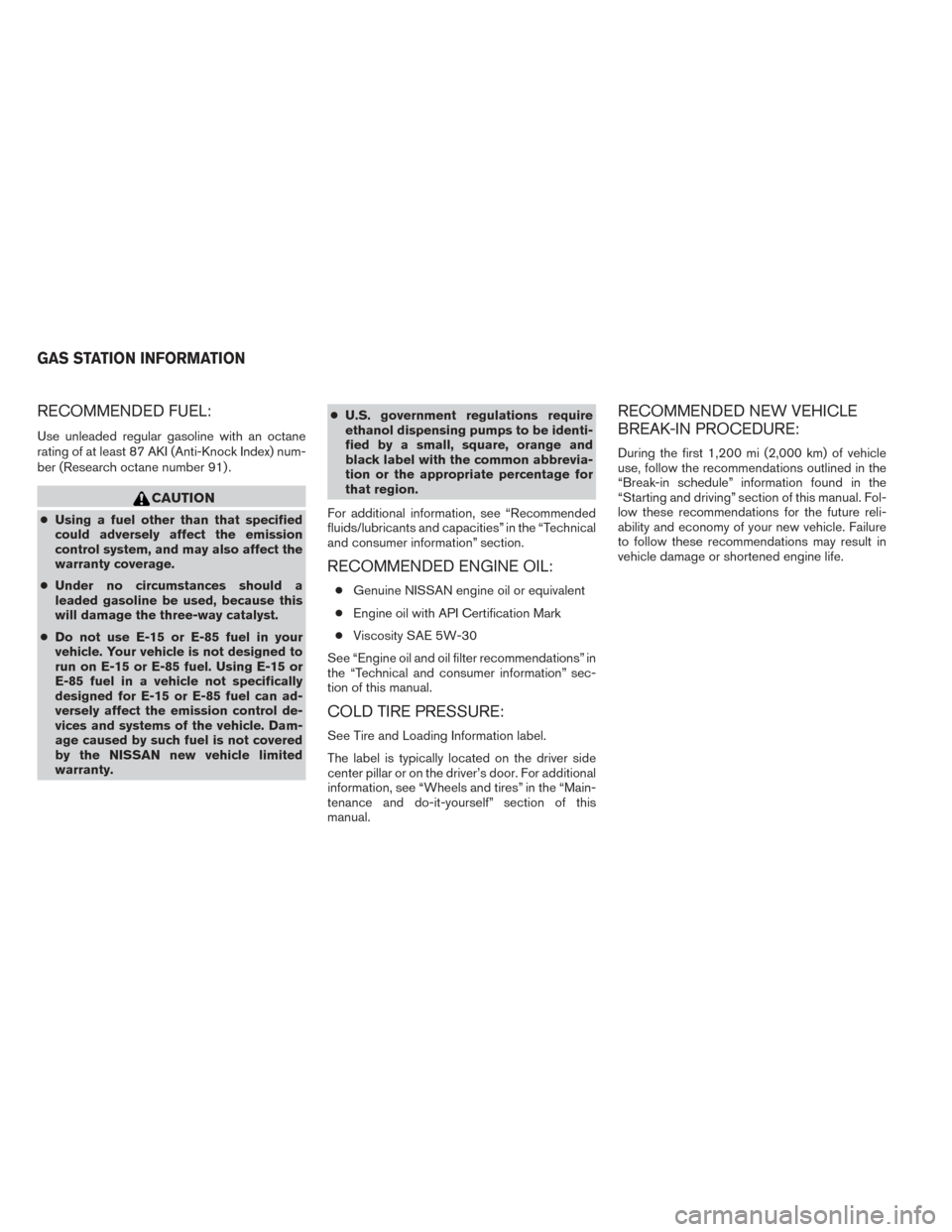
RECOMMENDED FUEL:
Use unleaded regular gasoline with an octane
rating of at least 87 AKI (Anti-Knock Index) num-
ber (Research octane number 91) .
CAUTION
●Using a fuel other than that specified
could adversely affect the emission
control system, and may also affect the
warranty coverage.
● Under no circumstances should a
leaded gasoline be used, because this
will damage the three-way catalyst.
● Do not use E-15 or E-85 fuel in your
vehicle. Your vehicle is not designed to
run on E-15 or E-85 fuel. Using E-15 or
E-85 fuel in a vehicle not specifically
designed for E-15 or E-85 fuel can ad-
versely affect the emission control de-
vices and systems of the vehicle. Dam-
age caused by such fuel is not covered
by the NISSAN new vehicle limited
warranty. ●
U.S. government regulations require
ethanol dispensing pumps to be identi-
fied by a small, square, orange and
black label with the common abbrevia-
tion or the appropriate percentage for
that region.
For additional information, see “Recommended
fluids/lubricants and capacities” in the “Technical
and consumer information” section.
RECOMMENDED ENGINE OIL:
● Genuine NISSAN engine oil or equivalent
● Engine oil with API Certification Mark
● Viscosity SAE 5W-30
See “Engine oil and oil filter recommendations” in
the “Technical and consumer information” sec-
tion of this manual.
COLD TIRE PRESSURE:
See Tire and Loading Information label.
The label is typically located on the driver side
center pillar or on the driver’s door. For additional
information, see “Wheels and tires” in the “Main-
tenance and do-it-yourself” section of this
manual.
RECOMMENDED NEW VEHICLE
BREAK-IN PROCEDURE:
During the first 1,200 mi (2,000 km) of vehicle
use, follow the recommendations outlined in the
“Break-in schedule” information found in the
“Starting and driving” section of this manual. Fol-
low these recommendations for the future reli-
ability and economy of your new vehicle. Failure
to follow these recommendations may result in
vehicle damage or shortened engine life.
GAS STATION INFORMATION